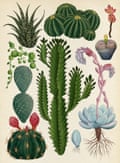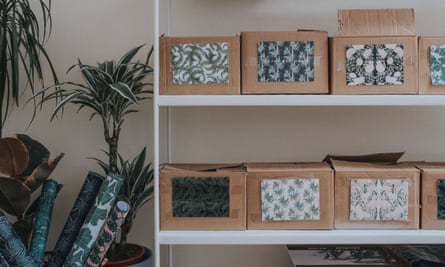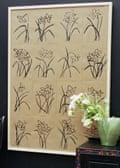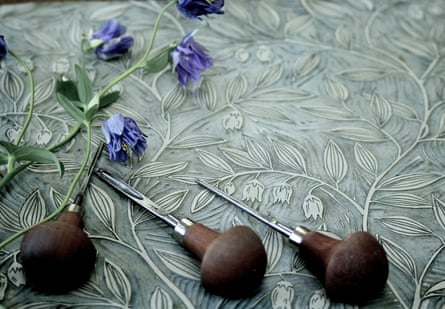Botanical illustration isn’t anything new but it is becoming increasingly popular as part of a wider greenery trend. The current Tradescant’s Orchard: A Celebration of Botanical Art exhibition at the Garden Museum in London is showing watercolours by 50 artists and there’s a botany theme at next month’s London Design Fair. Meanwhile, photography duo Haarkon are becoming known for self-initiated greenhouse tours which they post on Instagram. Plants are everywhere. For these illustrators and designers, what starts out as a drawing often ends up as textiles, original artwork or products for the home. Here are some of the best.
Katie Scott: plant illustrations

The Guardian’s product and service reviews are independent and are in no way influenced by any advertiser or commercial initiative. We will earn a commission from the retailer if you buy something through an affiliate link. Learn more.
Whether designing an album cover for the Bombay Bicycle Club or drawings for Botanicum, a children’s book on plant life published in association with Kew, London-based illustrator Katie Scott has a distinct part-scientific, part-surreal style.
“My drawings aren’t always completely accurate and they don’t need to be; they are decorative too,” she says of her artwork, which is hand-drawn and then coloured in on the computer by layering and blending scanned watercolour swatches.
Current homeware projects include ceramic candle pots for Berlin lifestyle brand Polkra, and a limited-edition cup and saucer for tea retailer T2 Tea (out in November) based on the flora of tea flavours. “They sent me a list of tea-related plants and I picked those that I thought would look good together, such as hibiscus and star anise.”
Appearance aside, she is also fascinated by the history of botanical illustration. “Sometimes I’ll think a plant is boring but then I’ll see it in an 18th-century painting and fall in love with it.”
Plans for the future? “I’d like to go into textiles so I’ve been designing and making cushions as testers.” katie-scott.com
Tuppence Collective: surface pattern design
Wes Anderson and William Morris: not the most likely pairing, yet north London’s Alicia Perry (above left) and Rebecca Intavarant (right), aka the Tuppence Collective, cite both as influences on their stationery. “Watching Wes Anderson’s films, we always notice the amazing wallpaper in the background of the interiors,” says Intavarant. “When we’re coming up with patterns, we ask ourselves: would Wes use this in a film? We also love the Arts and Crafts movement, so that’s our main inspiration.”

The pair met studying illustration at Coventry University and initially started out creating wedding stationery. “We had so many enquiries from people who weren’t getting married that last year we decided to branch out.” It was a gamble that paid off. Now they count Fortnum & Mason and Daylesford among the stockists of their collection of wrapping paper, writing sets and cards. “It’s important that our designs appeal to men and women; just because they are plant patterns, we don’t want them to be girly.”
Next up: the London Design Fair in September, where new products include tropical Christmas cards and wrapping paper that fuses animal markings with botanicals. tuppencecollective.co.uk
Lucy Auge: botanical paintings

“I love talking about plants; I could bore your socks off about the subject,” says Somerset-based artist Lucy Auge, who is known for her calligraphy ink artwork series which are often painted over a season, in a specific location.
Usually a set consists of around 40 A4 paintings (they are sold individually) but for her first big show in Bath two years ago, she upped the number to 500 and used aged, 18th-century paper found in her godmother’s attic.
“I was going to do 1,000 paintings until my brother did the maths and worked out that I’d have to finish one every 10 minutes,” she jokes.
“I didn’t realise how old the paper was until I took it to a specialist to get more and discovered it was made in the same French mill that supplied Turner.”
Recently, she was commissioned to do a set of paintings for the refurbished Gleneagles hotel in Perthshire; now she is spending much of her time preparing for a London show next spring. “I’m still using inks but moving into colour,” she reveals. “I’m experimenting with my palette and trying to capture the spirit of the plants.” lucyauge.co.uk
Isla Middleton: textile design
In a digital age, textile designer Isla Middleton stands out for using traditional linocut print methods to create her nature-inspired cushions and fabrics.
“Many designers are going more into digital but I prefer the process of drawing, working out a repeat block and then transferring that pattern on to lino and paper before screen printing on natural fibres such as wool and Scottish linens,” explains Middleton.

She spends her spare time visiting gardens and nature reserves near where she lives in Herefordshire (Kentchurch Court is a favourite). Since graduating from Falmouth University last year, she has completed a placement at Sanderson and had an exhibition of her work at east London’s Botany shop, where her fabric swatches, lino blocks and prints were dotted about among the plants.
In September, her textiles will be on show at The Print Shed as part of Herefordshire Art Week. “For me, lino cutting gives a more unique, carved-out appearance to a print than a hand-drawn line would. With digital, I don’t have the same connection.” islamiddleton.co.uk

Comments (…)
Sign in or create your Guardian account to join the discussion